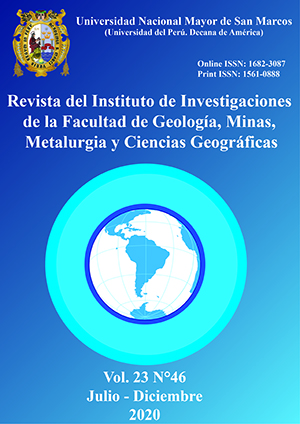Remote detection of NO2 in the tropospheric zone of South America and its spatial distribution
DOI:
https://doi.org/10.15381/iigeo.v23i46.19189Keywords:
Remote sensing, satellite image, NO2 aerial distributionAbstract
The polluting elements in the Earth's atmosphere, specifically throughout to the troposphere space that corresponds, NO2, are increasingly dispersed at higher altitudes, ranging from 0 meters above sea level to 10,000 meters above sea level, this study analyzes the behavior of this pollutant element at altitudes of 10 meters, 5 thousand meters and 10 thousand meters where the behavior of this pollutant shows saturation areas with this element in South America troposphere area, the NO2 among other gases that affect these atmospheric zones can be found at altitudes greater than one thousand meters that corresponds to the outer zone of boundary layer in the atmosphere, affecting air spaces even beyond the range of the troposphere, in this work, We analyze the lower, middle and upper areas of the troposphere, which in altitudes means at 10, 5,000 and 10,000 meters. The study visualizes the NO2 concentrations through the LANDSAT 8 satellite images corresponding to the year August 2020, in the extension of the surface area of South America, these images are acquired from the USG Survey of the USA, an Institution that belongs to NASA and that it has a constellation of satellites such as Terra, NOAA, Aster and LandSat dedicated to different studies of the planet's airspace. From the multispectral satellite images they are shown in the different areas of the airspace of the study area, being able to observe the variation of the presence of this polluting element, the analysis was carried out with the Global Mapper, free access software. The results obtained from the analysis of the satellite images indicate the behavior and level of saturation of the airspace in the area for NO2, indicating that, at altitudes greater than one thousand meters; This pollutant element remains in relevant concentrations that must be taken into account to provide the effects of climate change. The remote detection of NO2 at altitudes greater than a thousand meters shows cloud distribution of this gas and indicates that in the medium term, they will affect the temperature and thus make the climate vary. For this reason, it is necessary to carry out more studies in these areas to observe the parameters related to the climate in the surface area of the earth.
Downloads
Published
Issue
Section
License
Copyright (c) 2020 Alfonso Alberto omero Baylón, Silvia del Pilar Iglesias León

This work is licensed under a Creative Commons Attribution-NonCommercial-ShareAlike 4.0 International License.
AUTHORS RETAIN THEIR RIGHTS:
a. Authors retain their trade mark rights and patent, and also on any process or procedure described in the article.
b. Authors retain their right to share, copy, distribute, perform and publicly communicate their article (eg, to place their article in an institutional repository or publish it in a book), with an acknowledgment of its initial publication in the Rev. Inst. investig. Fac. minas metal cienc. geogr.
c. Authors retain theirs right to make a subsequent publication of their work, to use the article or any part thereof (eg a compilation of his papers, lecture notes, thesis, or a book), always indicating the source of publication (the originator of the work, journal, volume, number and date).






